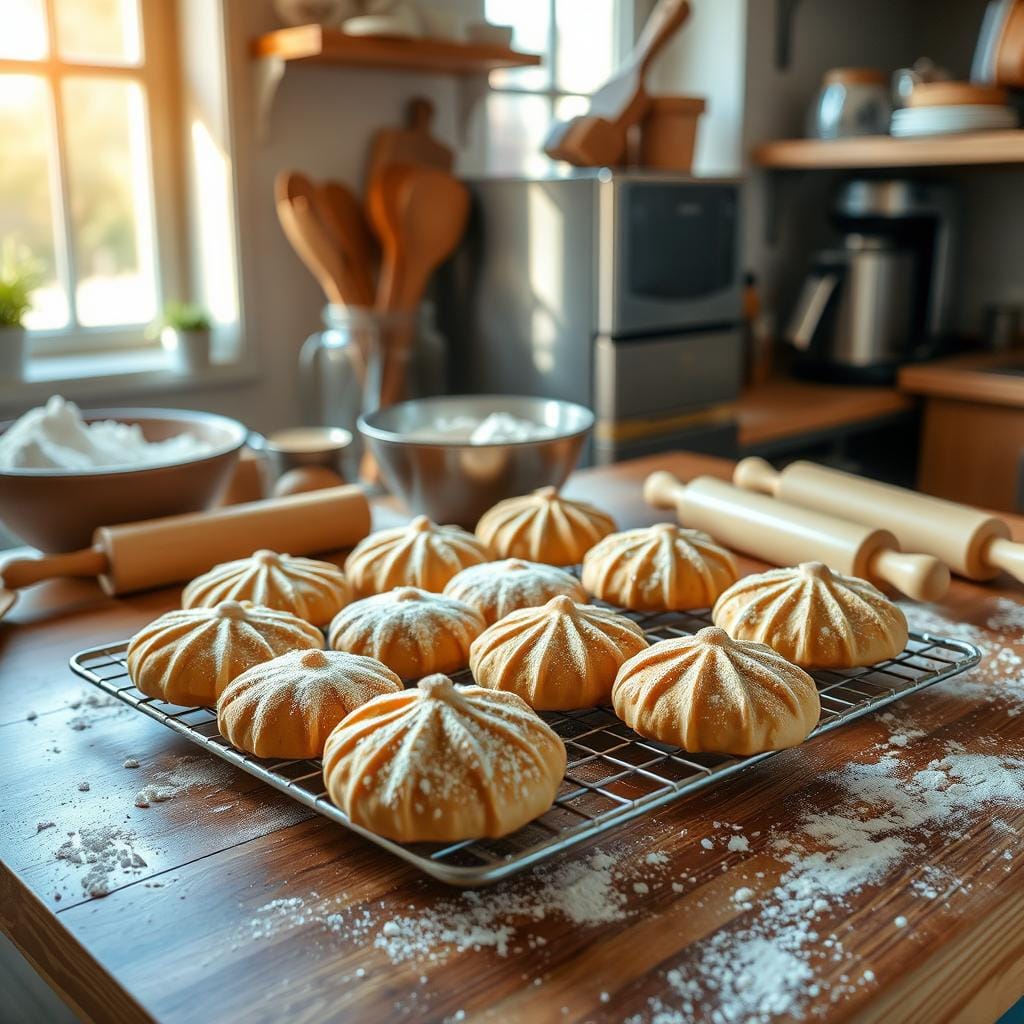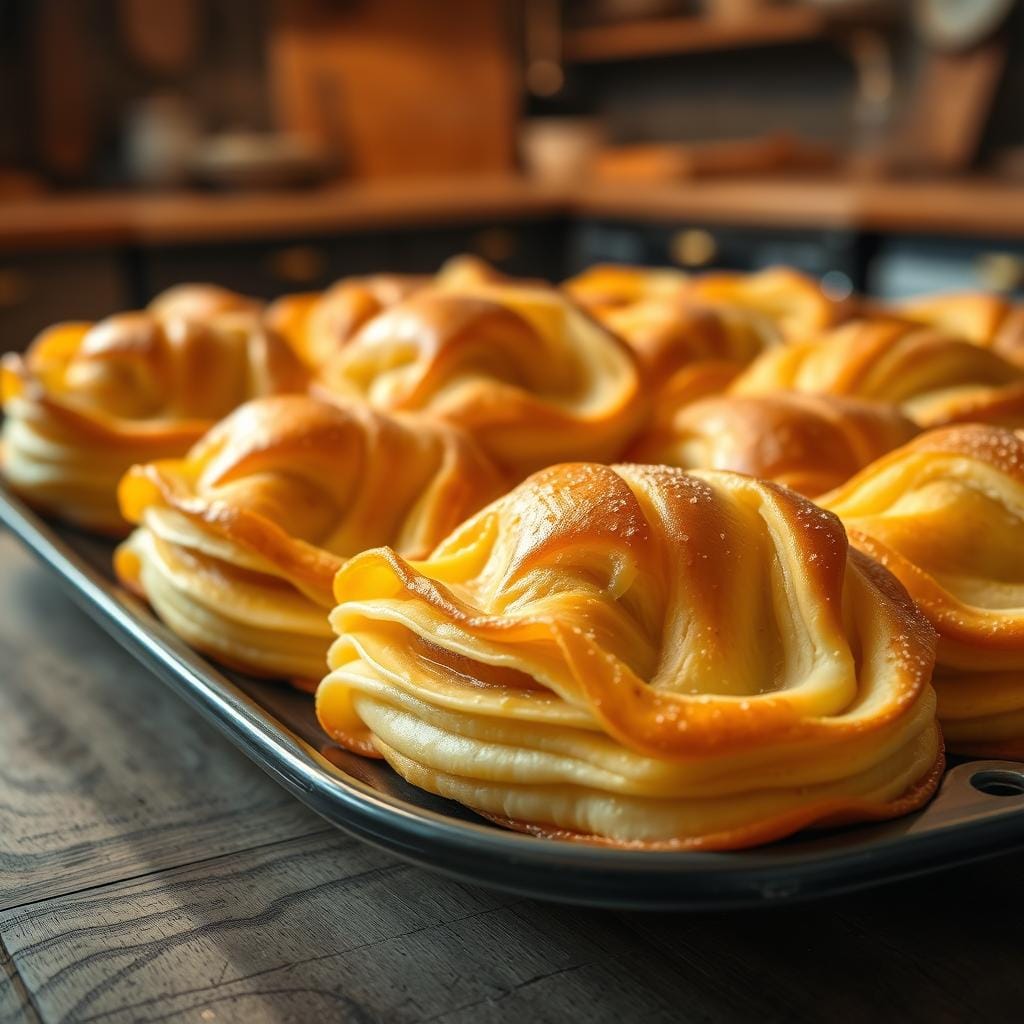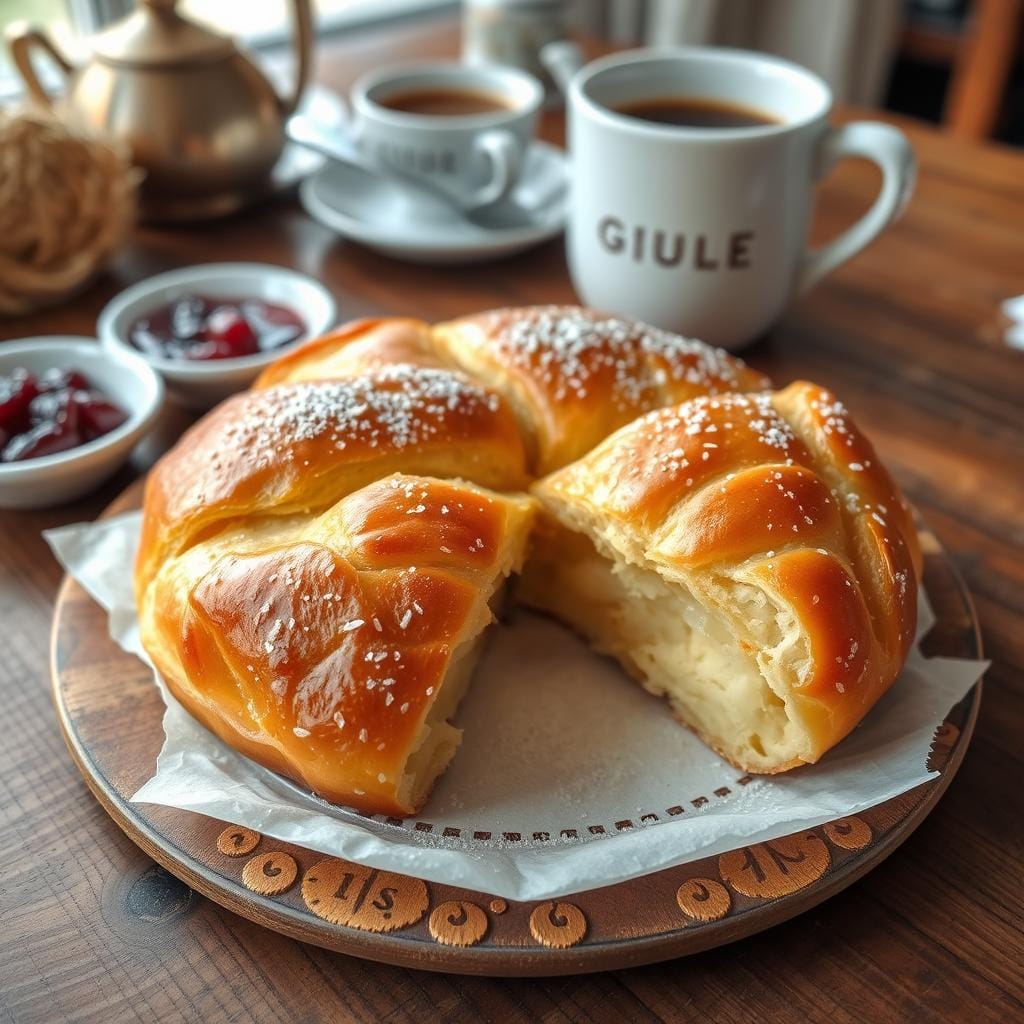gipfeli recipe : Imagine waking up to a crisp Swiss morning, with the aroma of fresh pastries filling the air. That’s the charm of Gipfeli—a beloved, delicious breakfast treat!
As you start this cooking adventure, you’ll learn how to make this Swiss favorite at home. You’ll get to enjoy buttery, flaky goodness right in your kitchen.

Table of Contents
Key Takeaways
- Discover the history and cultural significance of the Swiss gipfeli
- Learn the differences between gipfeli and French croissants
- Understand the essential ingredients and equipment needed for baking gipfeli
- Master the laminated dough technique for that perfect flaky texture
- Avoid common mistakes and learn top tips for achieving bakery-quality results
Understanding Swiss Gipfeli: The Traditional Swiss Breakfast Pastry
Gipfeli is a beloved Swiss breakfast pastry. It holds a special place in Swiss hearts and traditions. Unlike the French croissant, Gipfeli has its own rich history and cultural significance.
History and Cultural Significance
The Swiss Gipfeli has its roots in the 19th century. It quickly became a favorite in Swiss bakeries and homes. Today, it’s a key part of the Swiss breakfast, often enjoyed with coffee or tea.
Differences Between Gipfeli and French Croissants
Gipfeli and French croissants may look similar, but they taste and feel different. Gipfeli are buttery and flaky, with a sweeter taste. Their unique shaping and forming techniques make them stand out.
Types of Swiss Gipfeli recipe Variations
There are many variations of the Swiss Gipfeli. The Nussgipfel is a favorite, with a nutty filling. Other fillings include chocolate, fruit, and savory options, pleasing many tastes.
The Swiss croissant recipe and the art of making the perfect breakfast pastry, the Gipfeli, are treasured worldwide. They bring joy to Swiss communities everywhere.
Essential Ingredients for Perfect Swiss Gipfeli recipe
To make the perfect Swiss rich brioche pastry, known as Gipfeli, you need the right ingredients. At its core is a laminated dough. This dough makes the pastry flaky and buttery, a joy to eat. Let’s look at what you need to make these Swiss treats.
- Butter: High-quality butter is key for Gipfeli. It gives the pastry a tender crumb. Choose butter with a high fat content for a flakier texture.
- Flour: You’ll need bread flour and all-purpose flour for the dough. Bread flour adds chewiness, while all-purpose flour makes it light and airy.
- Yeast: Active dry yeast is crucial for the dough to rise. It creates the layered effect of a rich brioche.
- Sugar: A bit of granulated sugar adds sweetness. It balances the savory flavors of the Gipfeli.
- Salt: A pinch of salt enhances the flavors. It brings out the best in the other ingredients.
While traditional Gipfeli is loved, there’s also the mandelgipfel with almond filling. These variations show how versatile this Swiss pastry is. They let bakers add their own twist to the classic Gipfeli.
“The secret to a perfect Gipfeli lies in the quality of the ingredients and the care taken in the lamination process.”
Equipment and Tools Needed for Baking gipfeli recipe
Making the perfect flaky viennoiserie like Swiss Gipfeli needs the right tools. You’ll need both basic baking tools and some professional gadgets. The right setup is key to getting the best results.
Must-Have Baking Equipment
- Heavy-duty stand mixer with a paddle attachment for kneading the dough
- Rolling pin for evenly shaping and rolling out the laminated dough
- Baking sheets or pans lined with parchment paper for shaping and baking the Gipfeli
- Pastry brush for applying egg wash or other finishing touches
- Bench scraper for effortlessly handling the dough and cutting it into portions
Optional Tools for Professional Results
While the basics are enough to start, some extra tools can improve your baking techniques. They help you make flaky viennoiserie that’s as good as a bakery’s:
- Pastry mat or silicone baking mat for easy rolling and shaping
- Dough scraper or pastry cutter for clean, precise dough cuts
- Infrared thermometer for precise temperature monitoring
- Convection oven for even, consistent baking
Temperature Control Essentials
Keeping the right temperature is vital when working with flaky viennoiserie dough. Make sure you have:
- Reliable oven thermometer to monitor oven temperature
- Instant-read thermometer for checking internal dough temperature
- Cool, humidity-controlled environment for proofing and chilling the dough
Precision and attention to detail are key when baking flaky viennoiserie like Swiss Gipfeli. The right tools and temperature control can make all the difference in achieving the perfect texture and flavor.
Mastering the Laminated Dough Technique
To make Swiss Gipfeli, a traditional Swiss breakfast pastry, you need to master laminated dough. This technique involves folding and rolling the dough with butter layers. It’s key for the flaky texture of Gipfeli.
Learning laminated dough is about understanding the science behind it. The dough and butter layers trap air, making Gipfeli flaky and light.
- Start with a chilled, pliable dough that can handle folding and rolling.
- Make sure to mix the butter evenly to keep it intact during lamination.
- Keep an eye on the temperature to maintain the dough and butter balance.
With practice, you’ll get the flaky outside and airy inside of Gipfeli right. Embrace lamination to make these Swiss pastries at home.
| Key Factors for Successful Laminated Dough | Explanation |
|---|---|
| Dough Consistency | The dough should be well-chilled and pliable, yet firm enough to withstand the folding and rolling process without tearing. |
| Butter Integration | The butter must be evenly incorporated into the dough, maintaining its integrity throughout the lamination steps. |
| Temperature Control | Consistent temperature is crucial to ensure the delicate balance between the dough and butter layers is maintained. |
Mastering laminated dough will help you make perfect Gipfeli. They’ll have a flaky outside and a light inside, true to Swiss baking.
“The key to achieving the perfect laminated dough is to respect the process and embrace the science behind it. It’s a dance between the dough and the butter, and with each careful fold, you’re creating the foundation for a truly exceptional pastry.”
Step-by-Step Swiss Gipfeli Recipe Instructions
Learning to make authentic Swiss gipfeli recipe is a fun baking journey. Follow these steps to make flaky, buttery pastries in your kitchen.
Preparing the Dough Base
The dough is the heart of gipfeli. Mix flour, swiss butter, yeast, and sugar. Knead until smooth, then chill in the fridge for an hour.
Lamination Process
The flaky texture comes from lamination. Roll the dough into a rectangle, add swiss butter, fold, turn, and repeat. This builds the buttery layers.
Shaping and Forming Techniques
Now, shape the dough into crescents. Divide it, roll each into a crescent, and place on a baking sheet. Make sure they have space to rise.
With these steps, you’re ready to make delicious Swiss gipfeli. Improve your baking skills and enjoy the flaky, buttery taste of homemade gipfeli.
Tips for Achieving the Perfect Flaky Texture
Creating flaky, viennoiserie-style pastries like Swiss Gipfeli needs a deep understanding of baking. It’s all about how you handle the dough and keep the temperature just right. Every step is important for that flaky texture.
The lamination process is key to a flaky Gipfeli. You fold and roll the dough with butter, making thin layers. It’s all about the right technique and timing to keep the dough delicate.
- Keep the dough and equipment at the right temperature. This is crucial for flaky pastries.
- Be gentle with the dough and don’t over-knead. Too much handling can make it tough, not flaky.
- Try Swiss recipes like the Thunderbrew. They can add new flavors to your flaky Gipfeli.
By following these tips and mastering baking techniques, you’ll get flaky Swiss Gipfeli every time. It’s a delightful viennoiserie experience.
| Technique | Importance for Flaky Texture |
|---|---|
| Lamination | Creates distinct layers of dough and butter, resulting in the signature flaky structure. |
| Temperature Control | Ensures the dough and baking environment remain at the optimal temperature for proper rise and baking. |
| Gentle Dough Handling | Minimizes gluten development, preventing a dense, tough texture and preserving the delicate flaky layers. |

“Achieving the perfect flaky texture in Swiss Gipfeli is a delicate balance of science and art. With the right techniques and a keen eye for detail, you can create pastries that will delight your senses.”
Common Mistakes to Avoid When Making Swiss Pastries
Baking the perfect Swiss gipfeli recipe is a delicate art. Knowing and avoiding common mistakes can make your homemade pastries flaky and delicious. Whether you’re an experienced baker or new to baking techniques, these tips can improve your swiss croissant recipe and prevent disasters.
Temperature Control Issues
Keeping the right temperature is key when baking Swiss pastries. Dough that’s too warm can over-proof, while dough that’s too cold is hard to work with. Make sure to proof your dough at the right temperature and watch it closely to avoid these problems.
Dough Handling Errors
Handling the dough gently is crucial for a flaky texture. Overworking or using too much flour can make the pastry tough and dry. Handle the dough with care and follow the recipe closely for the best results.
Proofing Problems
Under-proofing or over-proofing can greatly affect your Swiss pastries’ texture. Watch the proofing times closely and adjust as needed due to temperature and humidity changes.
“Mastering Swiss pastry-making takes practice, but avoiding these common mistakes will help you create flaky, golden-brown Gipfeli that impress everyone.”
Storage and Reheating Guidelines
Keeping your homemade Swiss breakfast pastry or brunch baked goods fresh is key. Follow these easy tips to keep your Swiss Gipfeli delicious.
Proper Storage for Maximum Freshness
Store your Gipfeli in an airtight container at room temperature. Don’t refrigerate them, as cold air can make the dough stale. Enjoy your Gipfeli within 2-3 days for the best taste.
Reviving Gipfeli’s Flakiness
Want to make your Gipfeli crispy again? Preheat your oven to 350°F (175°C). Place the pastries on a baking sheet and warm them for 5-7 minutes. They’ll be crispy and delicious once more.
Serving Suggestions
- Enjoy your Gipfeli as a standalone breakfast pastry or with strong coffee for a Swiss brunch.
- Pair Gipfeli with croissants, muffins, or Danish pastries for a complete brunch.
- Add powdered sugar or honey on top for a sweet touch.

By following these tips, your homemade Swiss Gipfeli will stay fresh and tasty. You can enjoy the authentic taste of this breakfast pastry or brunch baked goods whenever you want.
Conclusion
In this guide, you’ve learned how to make the perfect Swiss gipfeli recipe. This traditional Swiss pastry has been loved for many years. You now know how to make the authentic Swiss butter braid recipe at home.
Starting your Swiss pastry-making journey is exciting. Remember to pay close attention to detail and control the temperature. These steps are key to making these treats special.
With practice and patience, you’ll make flaky, buttery Gipfeli like the ones in Swiss bakeries. So, get ready to bake. Put on your apron, preheat your oven, and enjoy making these Swiss gipfeli recipe. Share them with your loved ones and relish the history and culture in every bite. Happy baking!
FAQ
What is a Gipfeli?
A Gipfeli is a Swiss breakfast pastry. It’s like a croissant but with its own special touch. It’s known for being flaky and buttery, with a rich flavor.
What makes Gipfeli different from French croissants?
Gipfeli and French croissants are similar but different. Gipfeli has a richer dough and a flakier texture. This makes it unique compared to French croissants.
What are the different types of Gipfeli variations?
There are many Gipfeli variations. Nussgipfel has nuts, and Mandelgipfel has almonds. These fillings add extra flavor and texture.
What are the essential ingredients for making gipfeli recipe?
To make Gipfeli, you need high-quality butter, flour, yeast, and eggs. These ingredients make the dough rich and the pastry flaky.
What equipment and tools are needed for baking Gipfeli?
You’ll need a stand mixer, rolling pin, and baking sheets. A dough sheeter is optional. Keeping the temperature right is key for the dough.
How do you master the laminated dough technique for gipfeli recipe?
To get the flaky layers, you need to fold and roll the dough carefully. This creates layers of butter and dough, which is crucial for the texture.
What are the steps for making Swiss Gipfeli at home?
First, prepare the dough base. Then, go through the lamination steps. Finally, shape and form the Gipfeli. Each step is important for the best result.
How can you achieve the perfect flaky texture in gipfeli recipe?
For a flaky texture, focus on temperature, dough handling, and baking. Pay attention to every detail to get the light and airy layers.
What are some common mistakes to avoid when making Swiss pastries?
Avoid temperature issues, dough handling mistakes, and proofing problems. Knowing these common pitfalls can help you make perfect Gipfeli.
How should you store and reheat Gipfeli?
Store Gipfeli properly to keep them fresh. Gently reheat them to restore their flaky texture. This ensures they stay delicious.
